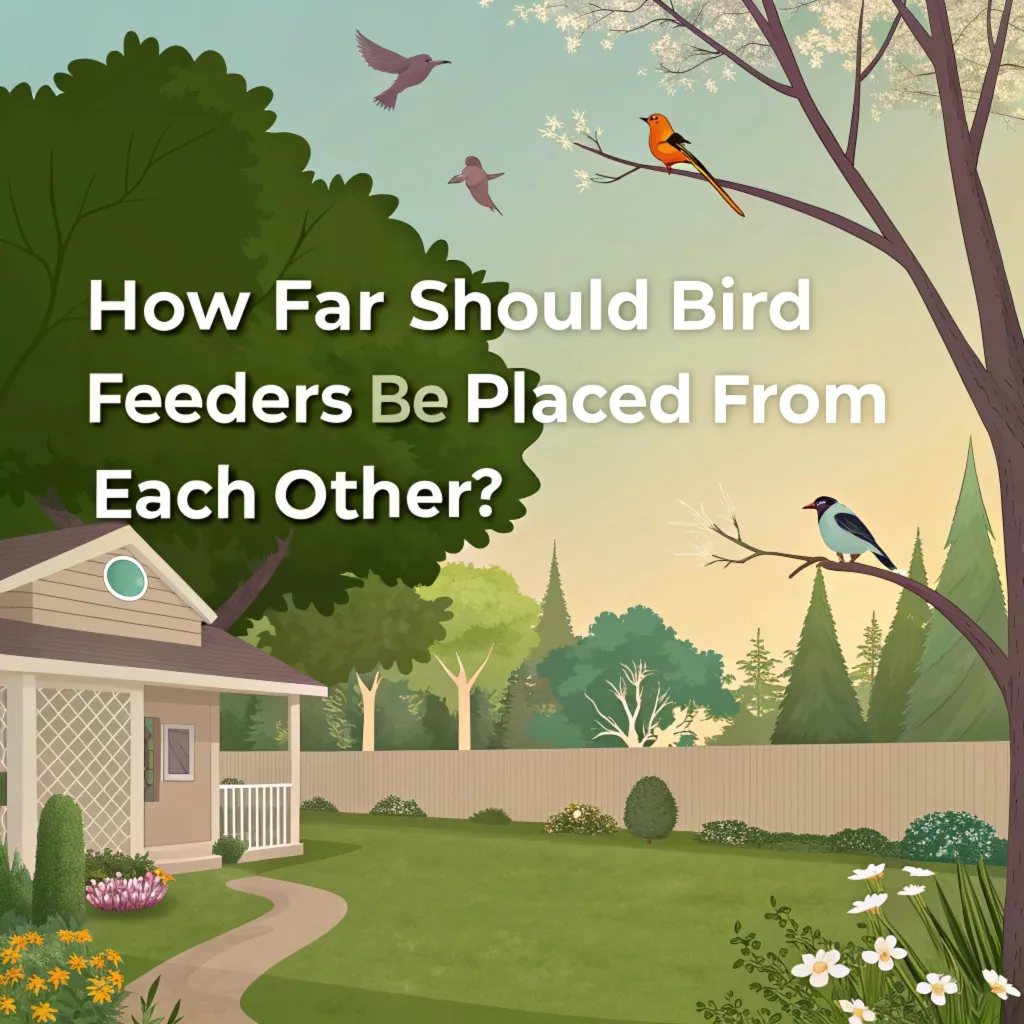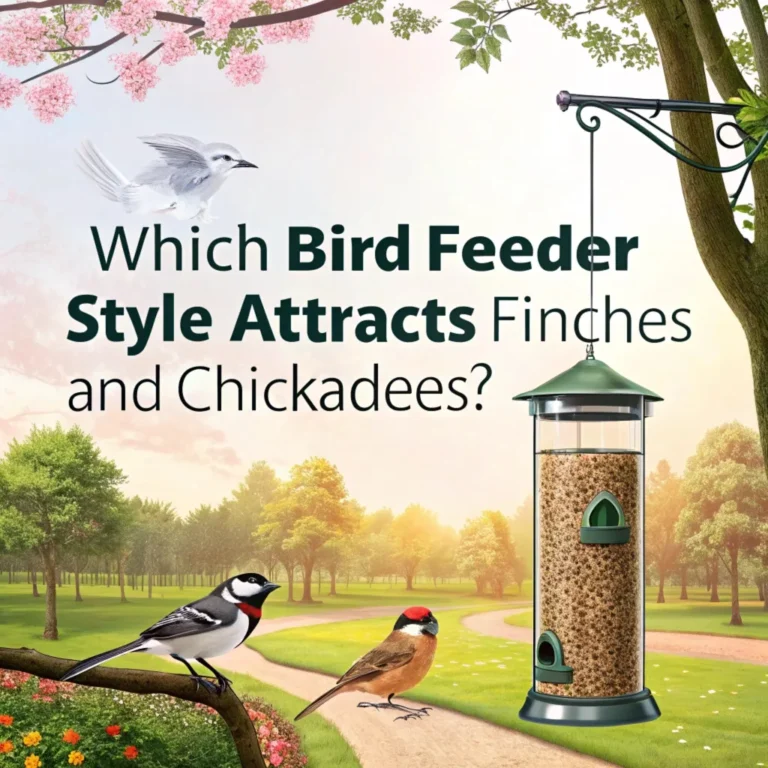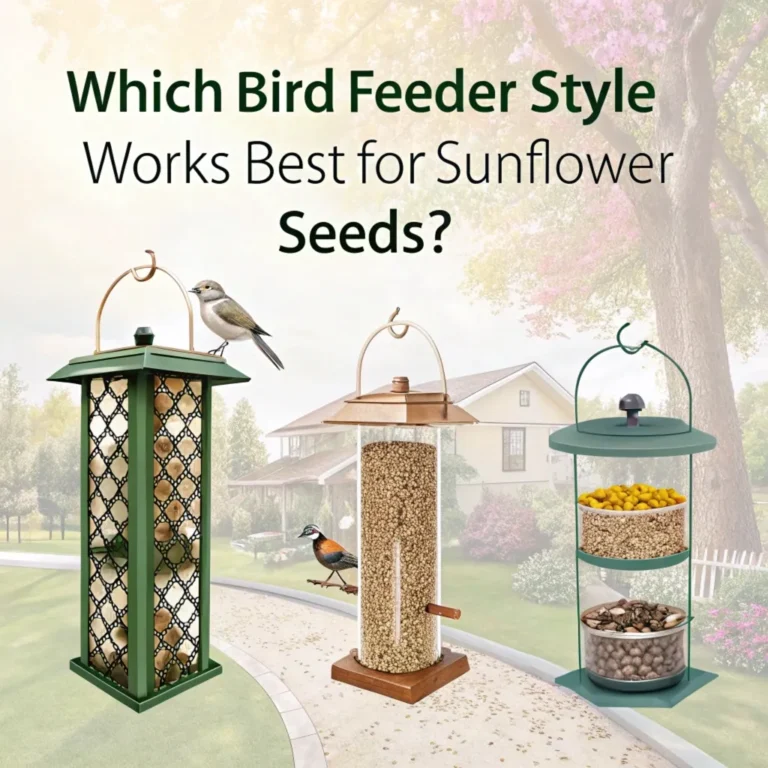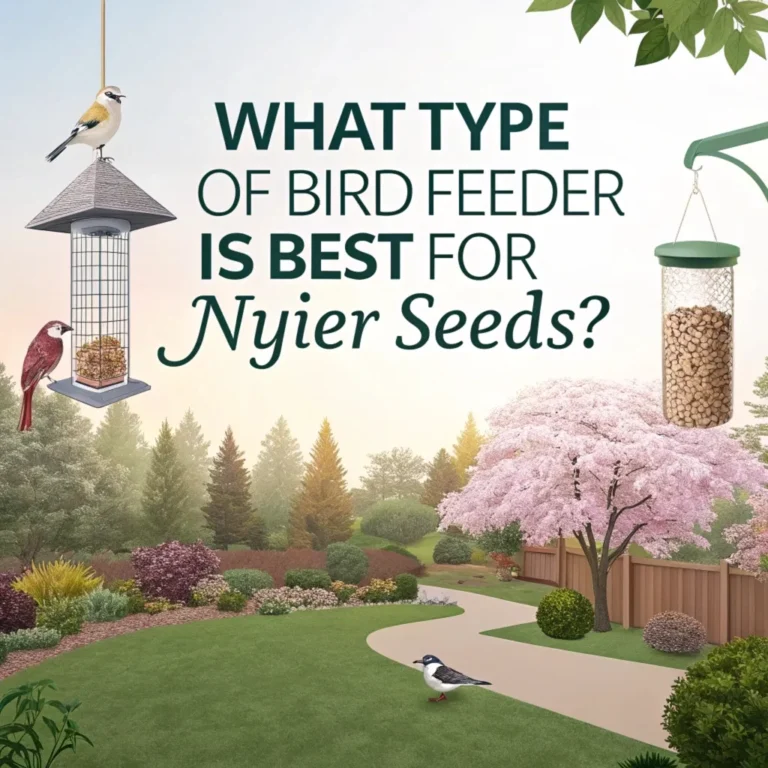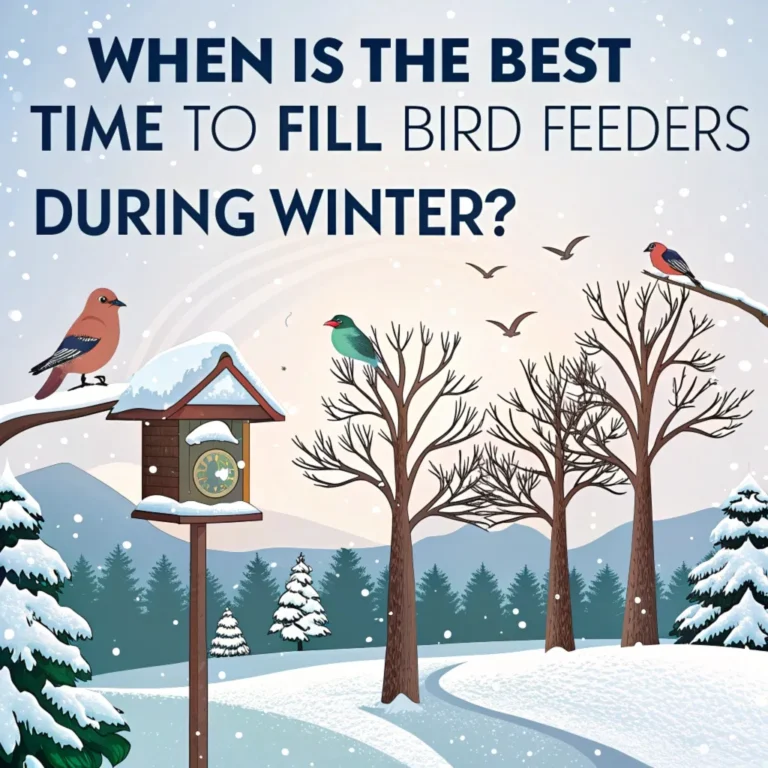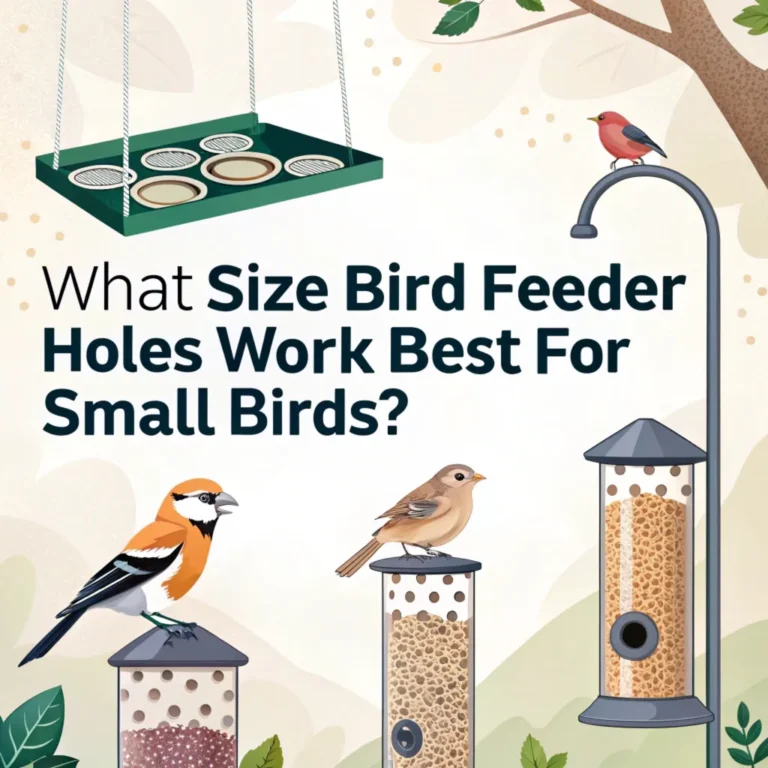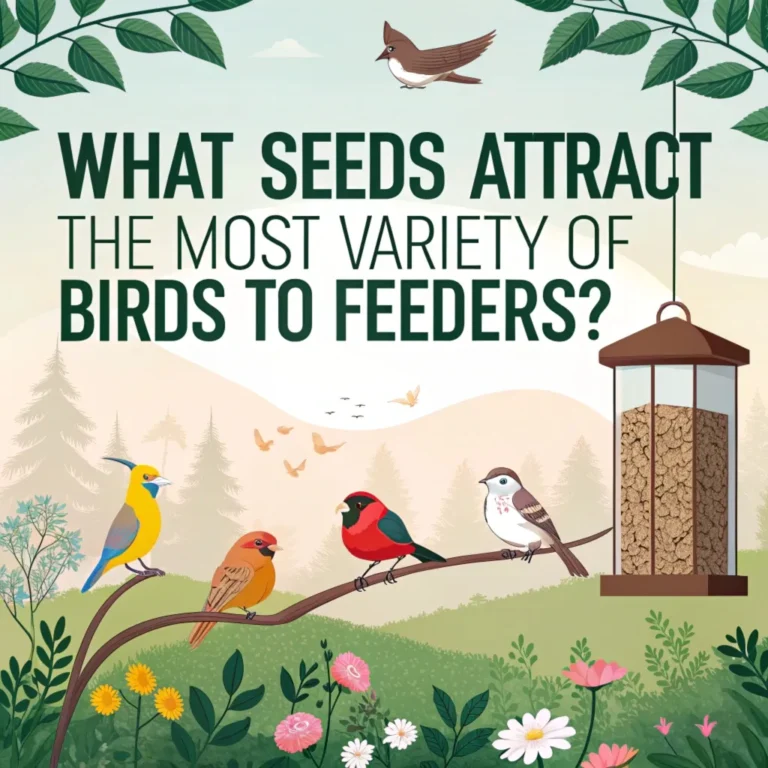How Far Should Bird Feeders Be Placed From Each Other?
Creating a welcoming environment for birds in your backyard involves more than just setting up feeders.
The strategic placement of these feeders plays a crucial role in attracting a diverse array of feathered visitors.
This post explores the ideal distances between bird feeders and other key elements in your yard to ensure a safe and inviting space for our avian friends.

Key Takeaways
- Multiple feeding stations at various heights attract more bird species
- Place feeders 3 feet or more than 10 feet from windows to prevent collisions
- Position feeders at least 15 feet away from bushes to protect birds from predators
- Keep feeders 10-15 feet away from trees and structures to deter squirrels
- Spread out feeders in different locations to accommodate various bird preferences
- Consider placing feeders 50 yards apart to reduce competition and stress
- Hummingbird feeders should be in shady, wind-protected areas
- Ground feeders cater to species like sparrows and juncos
- Elevated feeders attract finches, chickadees, and woodpeckers
- Regular cleaning and maintenance of feeders is essential for bird health
Optimal Distances Between Feeders
The spacing between bird feeders is crucial for creating a harmonious feeding environment. Placing feeders too close together can lead to overcrowding and competition, while spreading them too far apart might limit bird activity.
A general rule of thumb is to space feeders about 3 to 4 feet apart. This distance allows birds to move comfortably between feeders without feeling crowded.
Proper feeder spacing not only reduces competition but also promotes a diverse bird population in your yard. When feeders are placed at optimal distances, different bird species can coexist peacefully, each finding their preferred feeding spot.
This arrangement encourages a vibrant ecosystem where various birds can thrive, from small finches to larger woodpeckers.
Consider the feeding habits of different bird species when arranging your feeders. Some birds, like chickadees, prefer to quickly grab a seed and retreat to a nearby perch to eat. Others, such as mourning doves, may spend more time at the feeder.
By providing adequate space between feeders, you accommodate these different feeding styles and create a more inclusive environment for all your feathered visitors.
Feeder Placement from Windows
To protect birds from window collisions, place feeders either very close (within 3 feet) or far away (more than 10 feet) from windows.
This strategy reduces the risk of fatal impacts, as birds taking off from feeders within 3 feet of a window are less likely to gain enough speed for a dangerous collision.
Window collisions are a significant threat to birds, especially in urban and suburban areas. By strategically placing feeders, you can significantly reduce this risk.
When feeders are placed close to windows, birds are less likely to build up enough speed to cause serious injury if they do fly into the glass. Conversely, feeders placed far from windows give birds ample space to maneuver and avoid collisions altogether.
Consider using window decals or UV-reflective stickers in addition to proper feeder placement. These visual deterrents can further reduce the risk of bird strikes by making windows more visible to flying birds.
Remember that even with these precautions, it’s important to monitor bird activity around your windows and adjust feeder placement if necessary to ensure the safety of your feathered visitors.
Distance from Bushes and Cover

While birds appreciate nearby cover for quick escapes, placing feeders too close to bushes can make them vulnerable to predators. Position your feeders at least 15 feet away from bushes or other dense vegetation.
This distance provides birds with enough space to spot potential threats while still having access to nearby shelter.
Balancing safety and comfort is key when positioning feeders near vegetation. The 15-foot rule offers birds a clear line of sight to detect approaching predators, such as cats or hawks, while still providing a quick escape route to nearby bushes.
This setup allows birds to feel secure while feeding, encouraging more frequent and prolonged visits to your yard.
Consider the types of birds you want to attract when planning your feeder and bush layout. Some species, like cardinals and jays, prefer feeding closer to cover, while others, such as finches and sparrows, are more comfortable in open areas.
By creating a variety of feeding zones at different distances from bushes, you can cater to a wider range of bird preferences and increase the diversity of species visiting your yard.
Spacing from Trees and Structures
To deter squirrels and other unwanted visitors, place feeders 10 to 15 feet away from trees, fences, and rooflines. Squirrels can jump up to 10 feet horizontally, so maintaining this distance helps keep your bird food safe and accessible only to your intended feathered guests.
Strategic feeder placement is crucial in the ongoing battle against squirrels and other clever mammals that might raid your bird feeders.
By keeping feeders at a safe distance from potential launching points, you create a challenging obstacle for these agile creatures. This not only protects the bird food but also ensures that your feathered friends can enjoy their meals without competition from furry intruders.
Consider using squirrel baffles or specially designed squirrel-proof feeders in addition to proper spacing. These devices can provide an extra layer of protection against persistent squirrels.
Remember that while squirrels can be frustrating, they are also part of the backyard ecosystem. Providing a separate feeding area for squirrels, far from your bird feeders, can help maintain a balanced and harmonious outdoor environment for all wildlife.
Multiple Feeding Stations
Creating diverse feeding zones in your yard can attract a wider variety of bird species. Some birds prefer open areas, while others feel more comfortable near vegetation. By spreading out your feeders, you accommodate different bird preferences and reduce competition at any single feeding spot.
Diversifying your feeding stations not only attracts more bird species but also creates a more dynamic and interesting backyard habitat.
Consider setting up different types of feeders in various locations – tube feeders in open areas for finches, platform feeders near shrubs for ground-feeding birds, and suet feeders on tree trunks for woodpeckers.
This variety ensures that birds with different feeding habits and preferences all find a suitable spot in your yard.
Pay attention to the vertical space in your yard as well. By placing feeders at different heights, from ground level to several feet high, you can attract a wider range of bird species.
This multi-level approach mimics natural feeding environments and can transform your backyard into a bustling bird sanctuary that’s both visually appealing and ecologically diverse.
Ground vs. Elevated Feeders
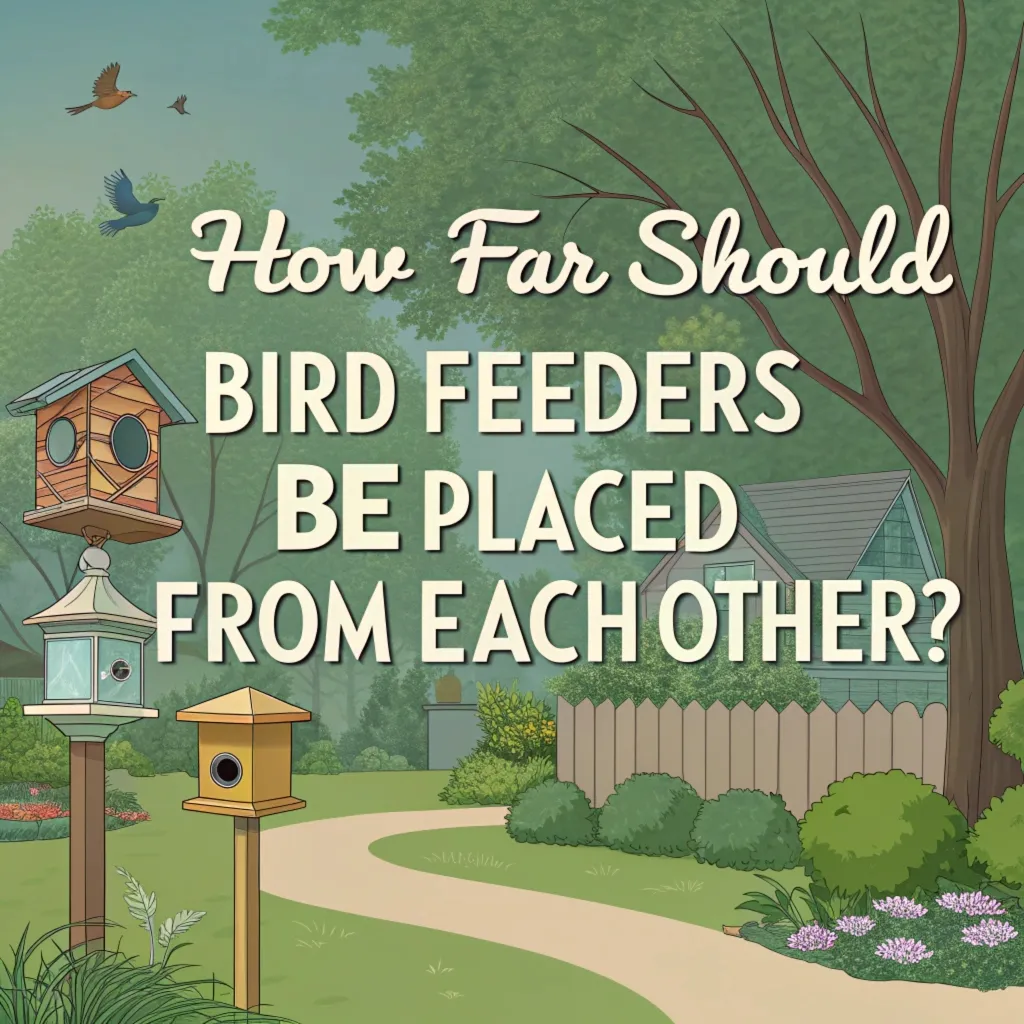
Incorporate a mix of feeder heights to cater to different bird species:
- Ground feeders: Attract sparrows, juncos, and towhees
- Shrub-level feeders: Ideal for finches and cardinals
- Elevated feeders: Preferred by chickadees, titmice, and woodpeckers
Varying feeder heights is a key strategy in creating a bird-friendly backyard ecosystem. Ground feeders, such as platform or tray feeders placed close to the ground, cater to species that naturally forage on the forest floor.
These feeders attract not only sparrows and juncos but also larger birds like doves and quail, adding diversity to your backyard bird population.
Elevated feeders, on the other hand, mimic the natural feeding habits of tree-dwelling birds. Hanging feeders or those mounted on poles can be adjusted to different heights, allowing you to experiment with what works best in your yard.
Remember to consider the surrounding landscape when positioning elevated feeders – ensure they’re visible to birds flying overhead and provide clear flight paths for easy access.
Hummingbird Feeder Placement
Hummingbird feeders require special consideration. Place these feeders in shady locations to prevent the nectar from spoiling quickly. Choose spots that are protected from strong winds to avoid spills.
Optimal hummingbird feeder placement is crucial for attracting these tiny, energetic birds to your yard. Hummingbirds prefer feeders that are easily visible but also offer some protection.
Consider hanging feeders near flowering plants that naturally attract hummingbirds, creating a comprehensive feeding zone that combines artificial and natural food sources.
Rotate your hummingbird feeder locations periodically to prevent territorial behavior among these feisty birds. By providing multiple feeding stations and changing their positions, you encourage a more diverse hummingbird population and reduce aggressive encounters.
Remember to clean hummingbird feeders frequently, especially in warm weather, to ensure the nectar remains fresh and safe for these delicate birds.
Feeder Distance for Nesting Birds
If you have birdhouses or nesting areas in your yard, keep feeders at a considerable distance from these sites.
A separation of at least 50 yards is recommended to reduce stress on nesting birds and minimize competition around their breeding areas.
Respecting nesting territories is crucial for supporting bird populations in your backyard. Nesting birds require a calm, undisturbed environment to successfully raise their young.
By keeping feeders at a distance, you reduce the traffic and potential conflicts near nesting sites, allowing parent birds to focus on caring for their offspring without unnecessary stress.
Consider the natural behavior of different bird species when planning your feeder and nesting box layout. Some birds, like bluebirds, prefer open areas for nesting, while others, such as wrens, favor more secluded spots.
By strategically placing feeders and nesting boxes in complementary locations, you create a balanced habitat that supports both feeding and breeding activities, contributing to the overall health of your local bird population.
Considerations for Urban Settings
In urban or limited-space environments, adapt these guidelines to fit your available area. Even small adjustments in feeder placement can make a significant difference in attracting birds while ensuring their safety.
Urban bird feeding presents unique challenges and opportunities. In compact spaces, focus on vertical arrangements of feeders to maximize your feeding stations without overcrowding.
Utilize balcony railings, window sills, and small garden areas creatively to provide diverse feeding options for birds in a limited space.
Consider the surrounding urban landscape when placing your feeders. In cities, birds often rely on small pockets of green space for food and shelter. By positioning your feeders strategically, you can create a vital resource for urban birds.
Pay attention to nearby trees, shrubs, or green corridors that birds might use for cover, and place your feeders in relation to these natural elements to create a safe and attractive feeding area.
Seasonal Adjustments
Consider adjusting feeder placement seasonally. During breeding seasons, you might spread feeders further apart to reduce competition. In winter, clustering feeders closer together can create a concentrated food source for birds.
Seasonal feeder adjustments reflect the changing needs of birds throughout the year. In spring and summer, when natural food sources are abundant, spreading feeders out encourages birds to forage more widely, supporting their natural behaviors.
This arrangement also helps reduce the concentration of birds in one area, which can be beneficial during nesting season when birds are more territorial.
During the harsh winter months, grouping feeders closer together creates a reliable food hub for birds when natural sources are scarce. This clustering can also help birds conserve energy by reducing the distance they need to travel between feeders.
However, be mindful of maintaining enough space between feeders to prevent overcrowding and potential disease spread. Regular cleaning becomes even more crucial when feeders are closer together.
Maintenance and Cleanliness
Regardless of placement, regular cleaning and maintenance of your feeders is crucial. Clean feeders every few weeks and more frequently during wet weather to prevent the spread of diseases among birds.
Proper feeder hygiene is as important as optimal placement for maintaining a healthy bird population in your yard. Dirty feeders can become breeding grounds for harmful bacteria and fungi, potentially causing diseases that can spread rapidly among birds.
Establish a regular cleaning schedule for all your feeders, using a mild bleach solution or bird-safe disinfectant to thoroughly clean and rinse each feeder.
Pay special attention to the areas around your feeders as well. Regularly rake or clean up spilled seeds and hulls beneath feeders to prevent mold growth and discourage rodents.
This practice not only keeps your yard tidy but also reduces the risk of ground-feeding birds ingesting spoiled food. Consider using seed catchers or platform trays beneath hanging feeders to make cleanup easier and minimize waste.
Observing Bird Behavior
Pay attention to bird behavior at your feeders. If you notice excessive aggression or certain species dominating the feeders, consider adjusting their placement or adding more feeding stations.
Careful observation of bird interactions at your feeders can provide valuable insights into the effectiveness of your feeder placement.
Look for signs of stress or conflict, such as birds frequently chasing each other away or certain species avoiding the feeders altogether. These behaviors might indicate that your current setup is favoring some species over others.
Use your observations to make informed adjustments to your feeder arrangement. For example, if you notice smaller birds being bullied by larger ones, try adding some feeders specifically designed for smaller species, placed in areas less accessible to larger birds.
Creating separate feeding zones for different bird sizes and species can help ensure a more harmonious feeding environment and increase the diversity of birds visiting your yard.
Adapting to Your Specific Environment
Every backyard is unique. Experiment with different feeder placements and observe the results. The goal is to create a safe, accessible, and inviting space for a diverse array of bird species.
Customizing your feeder setup to suit your specific backyard environment is key to attracting a wide variety of birds. Consider factors such as the natural landscape, existing vegetation, and local bird populations when deciding on feeder placement.
For instance, if your yard has a water feature like a pond or birdbath, try positioning some feeders nearby to create a comprehensive bird oasis.
Be prepared to adjust and refine your feeder arrangement over time. As you become more familiar with the birds in your area and their preferences, you can tailor your setup to better meet their needs.
This might involve moving feeders to more favorable locations, introducing new types of feeders, or even planting bird-friendly vegetation to complement your feeding stations.
Remember, creating the ideal bird habitat is an ongoing process that evolves with your observations and experiences.
Balancing Aesthetics and Functionality
While optimizing for bird safety and comfort, also consider the visual appeal of your feeder arrangement. Strategically placed feeders can enhance the beauty of your outdoor space while serving their primary purpose.
Integrating bird feeders into your overall landscape design can create a harmonious and visually pleasing backyard environment.
Consider the color and style of your feeders in relation to your garden or patio decor. Natural wood or metal feeders can blend seamlessly with outdoor settings, while colorful feeders can add vibrant accents to your yard.
Explore creative ways to incorporate feeders into your garden design. For example, you might use decorative shepherd’s hooks to hang feeders at varying heights, creating an attractive vertical element in your garden.
Or, consider building a dedicated bird feeding station that serves as a focal point in your yard, combining multiple feeder types with plantings that attract birds.
By thoughtfully arranging your feeders, you can create a backyard that’s not only a haven for birds but also a beautiful and enjoyable space for you to observe and appreciate nature.
FAQs
How far apart should different types of bird feeders be placed?
Different types of bird feeders should be placed about 3 to 4 feet apart. This spacing allows various bird species to feed comfortably without overcrowding.
Can bird feeders be too close to each other?
Yes, bird feeders placed too close together can lead to increased competition and stress among birds. Spacing them at least 3 feet apart helps reduce these issues.
Should bird feeders be placed near water sources?
Placing bird feeders near a water source, such as a birdbath, can be beneficial. However, maintain a distance of at least 3 to 4 feet between feeders and water to prevent food contamination.
How does feeder placement affect bird diversity in my yard?
Strategic feeder placement at various heights and locations in your yard can attract a wider variety of bird species. Ground feeders attract different birds compared to elevated feeders.
Is it okay to place bird feeders under trees?
While trees provide natural shelter, placing feeders directly under trees can make them vulnerable to squirrels and other pests. Position feeders 10 to 15 feet away from trees for better bird safety.

Luna is the passionate founder and author of Birds and You, a website dedicated to sharing her love for birds with fellow enthusiasts. Through her engaging articles and guides, she aims to educate and inspire others to explore the fascinating world of birds. When she’s not writing, you can find Luna observing birds in their natural habitats or sharing beautiful bird photography on Pinterest. Join her on this journey to celebrate and protect our feathered friends!

